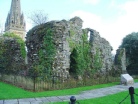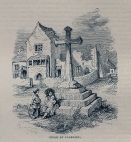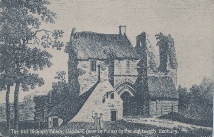Llandaff -



The City -
In 1107 Bishop Herwald was succeeded by Urban, the first purely Norman bishop of Llandaff. He was an active ecclesiastical reformer and an energetic builder, and he proceeded to rebuild the Cathedral and re-
Llandaff itself became the centre of a Norman lordship, including Canton, Ely, Fairwater, Llandaff North and Gabalfa. There was at times, friction between the adjacent lordships of Llandaff and Cardiff, as each, in its own way, was of prime importance in the Normanised parts of Glamorgan.
Until the nineteenth century restoration the Cathedral had no spire. But in the 13th century a campanile, or bell tower, was built on the village green, overlooking the Cathedral.
Also on The Green is the Preaching Cross where Archbishop Baldwin of Canterbury preached in support of the Third Crusade on his journey through Wales in 1188. He was accompanied by Giraldus Cambrensis (Gerald of Wales).


The main residence of the Bishop of Llandaff during the Middle Ages was the Bishop’s Castle, the picturesque shell of which stands at the southern end of The Green. It was built about 1280 and may have served a military purpose. In 1404 it was thoroughly sacked by Owain Glydwr and its appearance today is much as he left it.

The Archdeacon’s Castle was about half the size of the Bishop’s Castle and lay to the north of the Cathedral. It is said to have been destroyed in 1404 and there are no remains left.
In 1545 Bishop Kitchen was appointed. He leased and sold off much of the church’s property during his tenancy with the result that Llandaff remained, until the nineteenth century one of the poorest dioceses in Britain. He sold the manor of Llandaff to Miles Mathew in 1553, which included his main manor house (where the Cathedral School now stands) and land in Canton, Fairwater and Ely.
3
3